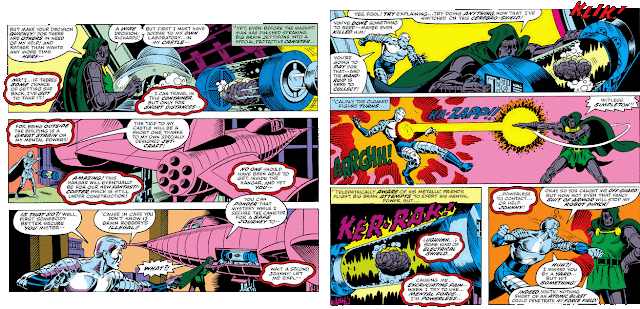Slipping by the PPC's roundup of other incarnations of the Fantastic Four was a late-1977 story by writer Roy Thomas which started the ball rolling after an earlier tale from 1972 successfully piqued reader interest on the subject. This time, the Watcher steps in for Lockjaw and guides us through the events of an alternate world in which Reed Richards, Ben Grimm, Johnny Storm, and Sue Storm returned from a disastrous flight into space and experienced different transformations than the members of our own famous quartet.
The appearance in this story of the FF we know is limited to the (appropriately enough) opening four pages of the issue (if you're not counting the slightly misleading cover which offers the impression that the two groups somehow come into conflict). Once the introduction has run its course, Thomas has made it clear he intends to further cement the premise he began exploring when he was scripting the main title, which floated the probability possibility that the FF's individual powers were the result of their personality traits*--even roping in the Watcher to validate what at this point is now formalized as canon rather than supposition.
*How we could possibly apply this theory to the powers of the Red Ghost and his three super-apes, all of whom underwent the same cosmic ray exposure which created the FF, is a fair point to raise. Kragoff himself, for instance, gains the ability to become "unsolid," while the baboon of the trio of apes becomes a shape-shifter and the orangutan gains magnetic abilities.
Which begs the question as to how the four individuals from an alternate Earth take on powers and forms so radically different from their counterparts.
Curiously enough, this world's "Fantastic Four" have somehow managed to successfully establish their heroic reputation in the public eye as a group of three, given that their fourth member, "Big Brain," cannot operate in the field for obvious reasons and instead appears content to remain within the confines of the Baxter Building. (His counterpart in the Fantastic Five from 1999 was obliged to find a way around the problem.) But when the three foil a museum robbery attempt, their fourth member cannot escape the scrutiny of the one who set that plan in motion.
As we'll see in the following scenes, Doom is as canny a foe on this Earth as he is on our own, and just as formidable against four super-powered opponents as he would be against a single individual. First, however, he focuses on Richards, deftly manipulating him in his bodiless state before finally dropping the sham and abducting him despite the interference of the "Mandroid" (a name which Thomas has demonstrated a peculiar fondness for over the years).
Whether by now we believe this Fantastic Four will be a match for Doom is a fair question to ask. The Mandroid, while having other abilities in addition to his strength, strikes out in nearly all respects against Doom; Dragonfly is about as effective as the Angel ever was; Big Brain is effectively contained; and Ultra-Woman's true purpose in this story is to serve as motivation for Reed's final confrontation with Doom, which reduces her own scene with their adversary to one of humiliation and ineffectiveness. Collectively, then, Doom sums up their threat against him perfectly: "I grow weary of hearing such threats from those who cannot back them up!"
As for this story's denouement, Doom has returned to the point where he is ready to engage his equipment which will destroy Reed's will in order to make use of his brain to power his time machine, reducing Reed's mind to that of a "human computer" subservient to himself. And despite Reed's last-minute resistance, Doom is able to again resist his best efforts (hmpf, some "Big Brain") and activate his device--but as to how that leaves us with the outcome we have, someone is in for a platinum no-prize if you can explain it to me.
Gee, Ben looks pretty happy considering he lost the woman he was in love with--while Reed makes quite a leap as to the reason why he felt obliged to give himself the name "Mr. Fantastic." (To be fair, no rationale has ever worked for the man in that regard.) As for the Watcher, in closing he again touts his iron-clad resolve to only "observe [and] not to influence the lives of such [people]"--a claim which the Watcher of that Earth, perhaps having peeked in on the activities of our own Watcher from time to time, might have had a good chuckle at.















3 comments:
I'd be concerned if I were Ben, Johnny, and Sue. If Reed is 100% truly in the driver's seat of his new body, why then is he still favouring that neo-medieval/gothic armour and tunic look? I suspect dark influences nested in that body somewhere. Best to act now before Reed starts growling "Callow clod of a peasant!"
This caliber of What If? story explains why the comic never became "must read" material for me.
Checking out the PPoC's round up of alternate incarnations of the FF, Comicsfan, I am astonished that so far you appear to have over-looked What If #11.
Come on, it was Jack Kirby's return to the FF in the 70s...
-sean
Oh ye of little faith, Sean. That issue received an honorable mention in a prior post related to the Bullpen.
Murray, I agree that the other team members should keep an eye on "Mr. Fantastic," at least for the time being, particularly since he's liable to be in a dour mood when he recalls just why Doom masked up in the first place.
Post a Comment